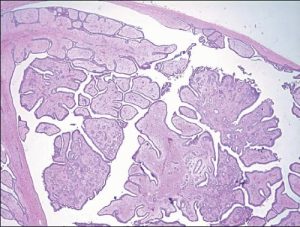Phyllodes Tumor of the Breast: What You Should Know
The phyllodes breast tumor is a rare type of neoplasm, accounting for less than 1% of all breast tumors. Its name comes from the characteristic leaf-shaped growth of its cells. Although it tends to grow rapidly, it rarely metastasizes.
Unlike him breast cancer, The phyllodes tumor develops from the stroma, the supporting tissue between the milk ducts and lobules, and not from the ducts or lobules themselves. However, it may contain elements of these tissues.
Benign or malignant phyllodes tumor?
In most cases, phyllodes tumors are benign. However, about 1 in 10 cases are malignant or intermediate in behavior. Regardless of its nature, the tumor grows rapidly and requires Surgical removal at an early stage, in order to reduce the risk of recurrence or metastasis.
Phyllodes tumors typically occur in women around 40 years of age. Benign forms can also be observed in younger women.

How is a phyllodes tumor diagnosed?
Typically, the phyllodes tumor is perceived as a painless, palpable mass which grows rapidly in size (2-4 cm or more). In rare cases, when the growth grows excessively, it can cause pain or ulcerative lesions on the skin.
Diagnosis can be challenging because phyllodes tumors closely resemble fibroadenomas—another benign breast lesion—which generally do not grow as fast and appear more often in younger women (20–30 years old).
Diagnosis is based on:
- Clinical examination
- Breast ultrasound, which offers valuable imaging information
- Mammography, where in 20% of cases the tumor is detected during the annual preventive check-up
- Biopsy, where the final diagnosis requires pathological assessment by a specialized physician, due to the morphological similarity to benign tumors such as fibroadenoma.
What is the treatment for phyllodes tumors?
The surgical excision with clear margins is essential, especially for borderline or malignant tumors. For benign tumors, the extent of excision can be individualized based on tumor size and breast anatomy. Local recurrence risk is higher for malignant tumors and when surgical margins are not clear. Close postoperative monitoring is crucial, especially during the first two years.
In some cases:
- Αν ο όγκος είναι πολύ μεγάλος ή το μέγεθος του μαστού μικρό, μπορεί να απαιτηθεί τμηματική or απλή μαστεκτομή.
- The breast radiotherapy δεν αποτελεί συνήθη πρακτική για όλους τους φυλλοειδείς όγκους, αλλά μπορεί να προταθεί σε κακοήθεις ή οριακού τύπου όγκους με αυξημένο κίνδυνο υποτροπής ή θετικά όρια εκτομής..
- Μεταστάσεις σε άλλα όργανα είναι σπάνιες, αλλά αν εμφανιστούν, τότε μπορεί να απαιτηθεί και χημειοθεραπεία.
Σημαντικό είναι ότι σπάνια απαιτείται χειρουργική παρέμβαση στη μασχάλη, καθώς οι axillary lymph nodes συνήθως δεν εμπλέκονται.
Emerging data suggest that malignant phyllodes tumors may eventually be treated with targeted therapies based on their genetic profile.
At BreastAware.gr παρέχουμε έγκυρη και κατανοητή ενημέρωση για όλες τις παθήσεις του μαστού, ώστε να είστε σωστά ενημερωμένοι για την υγεία σας. Επισκεφθείτε μας για περισσότερες πληροφορίες και υπεύθυνη καθοδήγηση από ειδικούς!
Bibliography:
- Liu Y. (2025). Recent advances and updated highlights in breast cancer pathologic diagnosis: a narrative review. Transl Breast Cancer Res, 6(3).
- Sars C, et al. (2023). Current clinical practice in the management of phyllodes tumors of the breast: an international cross-sectional study among surgeons and oncologists. Breast Cancer Res Treat, 199(2):293-304.
- Bogach J, et al. (2023). Phyllodes Tumors of the Breast: Canadian National Consensus Document Using Modified Delphi Methodology. Ann Surg Oncol, 30(11):6386-6397.
- Louie AD, Rosenberger LH. (2023). Phyllodes Tumors of the Breast: Addressing the Gaps in Consensus Recommendations for Clinical Management. Ann Surg Oncol, 30(11):6296-6298.
- Bansal R, et al. (2024). Genomic Landscape of Malignant Phyllodes Tumors Identifies Subsets for Targeted Therapy. JCO Precis Oncol, 8:e2400289.
- Choi N, et al. (2018). Malignant and borderline phyllodes tumors of the breast: a multicenter study of 362 patients (KROG 16-08). Breast Cancer Res Treat, 171(2):335-344.
- Tong Y, et al. (2024). The treatment process of a giant phyllodes tumor of the breast. Front Oncol, 14:1372710.
- Gradishar WJ, et al. (2022). Breast Cancer, Version 3.2022, NCCN Clinical Practice Guidelines in Oncology. J Natl Compr Canc Netw, 20(6):691-722.
- Karim RZ, et al. (2009). Pathogenic mechanisms in the initiation and progression of mammary phyllodes tumours. Pathology, 41(1):68-74
